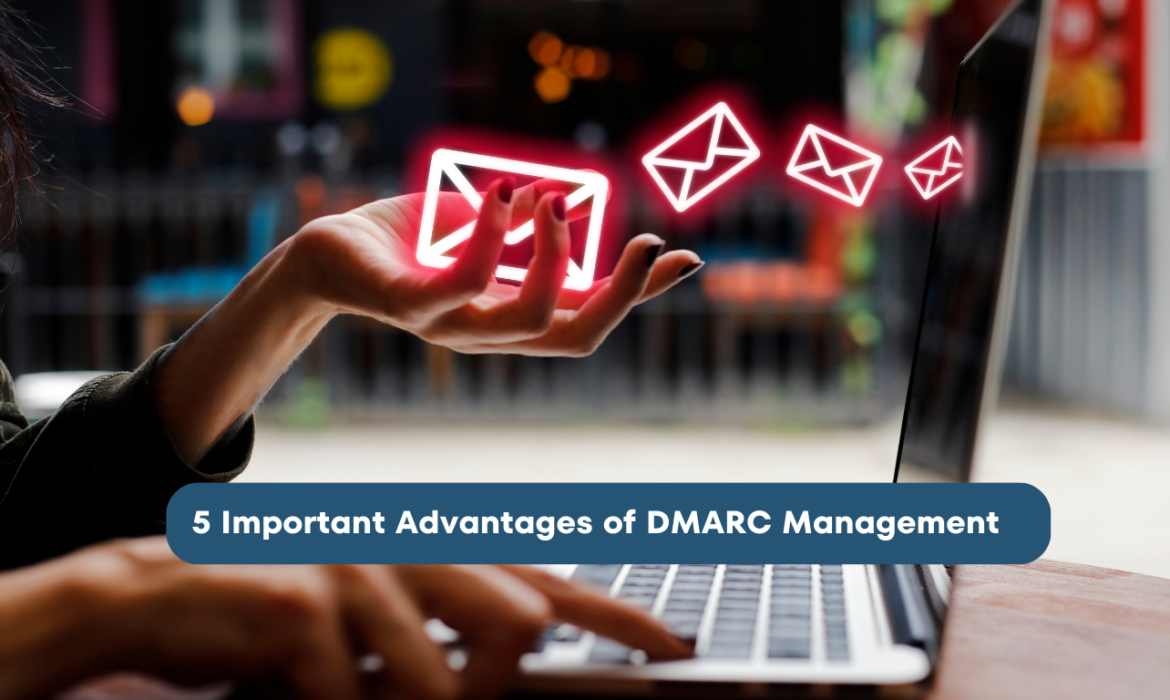5 Important Advantages of DMARC Management
In email security protocols, DMARC stands out as a game-changer. It’s not just a tool; it’s a powerful force that can safeguard your organization’s reputation and brand like never before. Delve into the depths of DMARC to unravel its hidden benefits and determine if it’s the right choice for your company.
TABLE OF CONTENTS
- Guardian against Phishing Attacks
- Why is it a crucial component of email security?
- Benefits of DMARC
- Top 5 DMARC Advantages that will alter the way you think about email authentication:
- DMARC offers significant benefits for both your brand reputation and email deliverability.
- Conclusion
- FAQ
Guardian against Phishing Attacks
DMARC, short for Domain-based Message Authentication, Reporting, and Conformance, emerges as the formidable shield businesses need to fend off phishing attacks. By implementing DMARC, you fortify your domain’s defenses, making it exponentially more challenging for malicious actors to deceive unsuspecting recipients with fraudulent emails.
Why is DMARC a crucial component of email security?
DMARC stands as a powerful solution for bolstering email security. This protocol works as a strong authentication framework, assuring that only fair emails reach your recipients’ inboxes. After using it, you specify a powerful defense against malicious actors trying to impersonate your domain or launch phishing attacks.
Benefits of DMARC
Enhanced Protection:
DMARC delivers more satisfactory security for your email system by preventing unauthorized senders from accessing your domain. It confirms the legitimacy of incoming emails, confirming that only authorized sources can deliver messages to your recipients.
Mitigation of Spoofing Attacks:
DMARC remarkably decreases the risk of spoofing, a method commonly employed by malicious actors to trick recipients. By confirming the authenticity of senders, DMARC check underestimates the possibilities of fraudulent emails occurring in your inboxes, protecting your organization and stakeholders from slipping victim to impersonation attempts.
Top 5 DMARC Advantages that will change the way you think about email authentication:
Use Domain Name to Find Scammers
To reveal the sources of email senders using your domain name from any location worldwide, you can implement different investigative techniques. While it’s essential to note that choosing the exact physical location of an email sender can be difficult due to the nature of the internet and the chance of IP address spoofing, you can still gather useful information to determine potential unauthorized senders.
SPF and DKIM
GoDmarc configures Sender Policy Framework (SPF) and DomainKeys Identified Mail (DKIM) for your domain. SPF identifies the authorized email servers that can send emails on behalf of your domain. On the other hand DKIM adds a digital signature to your outgoing messages, assuring their innocence and authenticity. Enforcing SPF and DKIM delivers extra layers of protection and prevents unauthorized parties from successfully spoofing or impersonating your domain.
Regularly Monitor Email Activity
Stay vigilant and scan your email domain for any signs of unauthorized use. Always keep an eye on email logs, authentication reports, and other appropriate metrics to determine any doubtful patterns or activities. If you see unauthorized email usage, take quick action to investigate and disable the unauthorized access.
Strong Passwords and Multi-Factor Authentication (MFA)
Maintain the security of your email accounts by implementing strong, distinctive passwords and enabling multi-factor authentication. This ensures that only trusted individuals with the valid credentials can access and utilize your email domain.
Employee Education and Security Awareness
Educate your employees on email security best practices, like identifying phishing attempts, avoiding suspect links or attachments, and reporting any uncommon email activity. By promoting a culture of security awareness, you can empower your workforce to recognize and report unauthorized email domain use promptly.
DMARC offers significant benefits for both your brand reputation and email deliverability.
For businesses using email marketing solutions in junction with their websites, it is important to have emails delivered straight to recipients’ inboxes. By implementing DMARC, you significantly lessen the possibilities of your domain being spoofed, eventually leading to a higher email deliverability rate. It means that more of your emails will drop in the desired inbox, rather than being relegated to trash or junk folders or filtered out as spam.
DMARC not only improves your brand reputation by investing trust in recipients but also improves email deliverability by mitigating the risks of domain spoofing. By utilizing DMARC for domain, you can optimize your email contacts and maximize the usefulness of your marketing efforts.
Summing Up!
GoDMARC streamlines the process of executing and implementing DMARC, makes it user-friendly for both end-users and Managed Security Service Providers (MSSPs). It provides a hassle-free approach to email authentication, eradicating the need for comprehensive technical expertise.
To kickstart your email authentication journey effortlessly, we encourage you to create a free account with GoDmarc. By doing so, you can start a 15-day DMARC trial and experience the advantages firsthand. Take control of your email security and prestige by harnessing the power of DMARC with GoDMARC.
Contact us now at Green Edge Computers now and check out GoDMARC pricing page to embark on a seamless DMARC implementation journey.
FAQs
How does DMARC improve email deliverability?DMARC helps improve email deliverability by reducing the chances of legitimate emails being marked as spam or filtered into junk folders. It ensures that emails are properly authenticated, preventing domain spoofing and unauthorized use, which can negatively impact deliverability rates.
- How does DMARC protect against domain spoofing and phishing attacks?
DMARC management enforces strict email authentication policies, verifying the authenticity of incoming emails. This protection prevents malicious actors from impersonating your domain and sending fraudulent emails, reducing the risk of phishing attacks and brand abuse.



